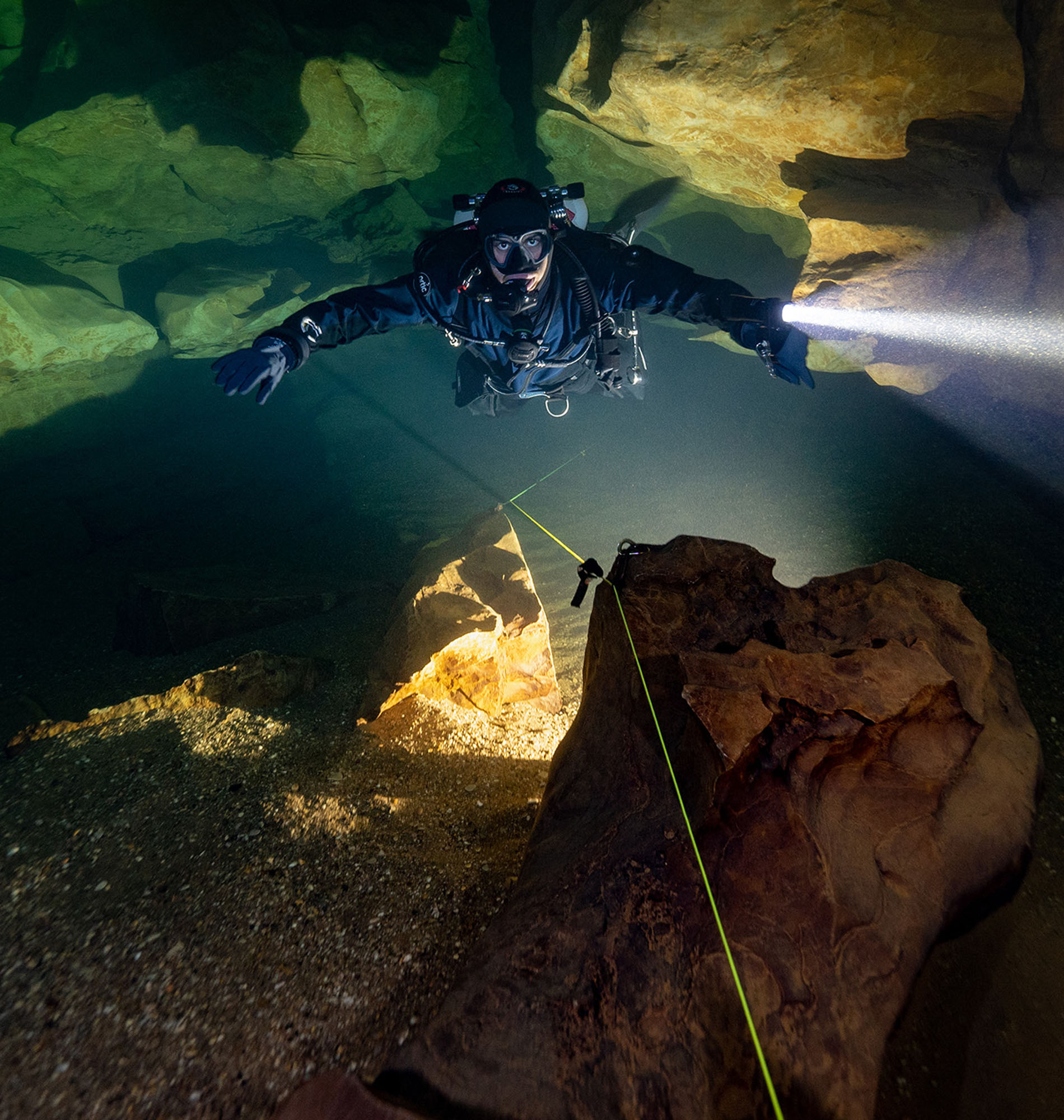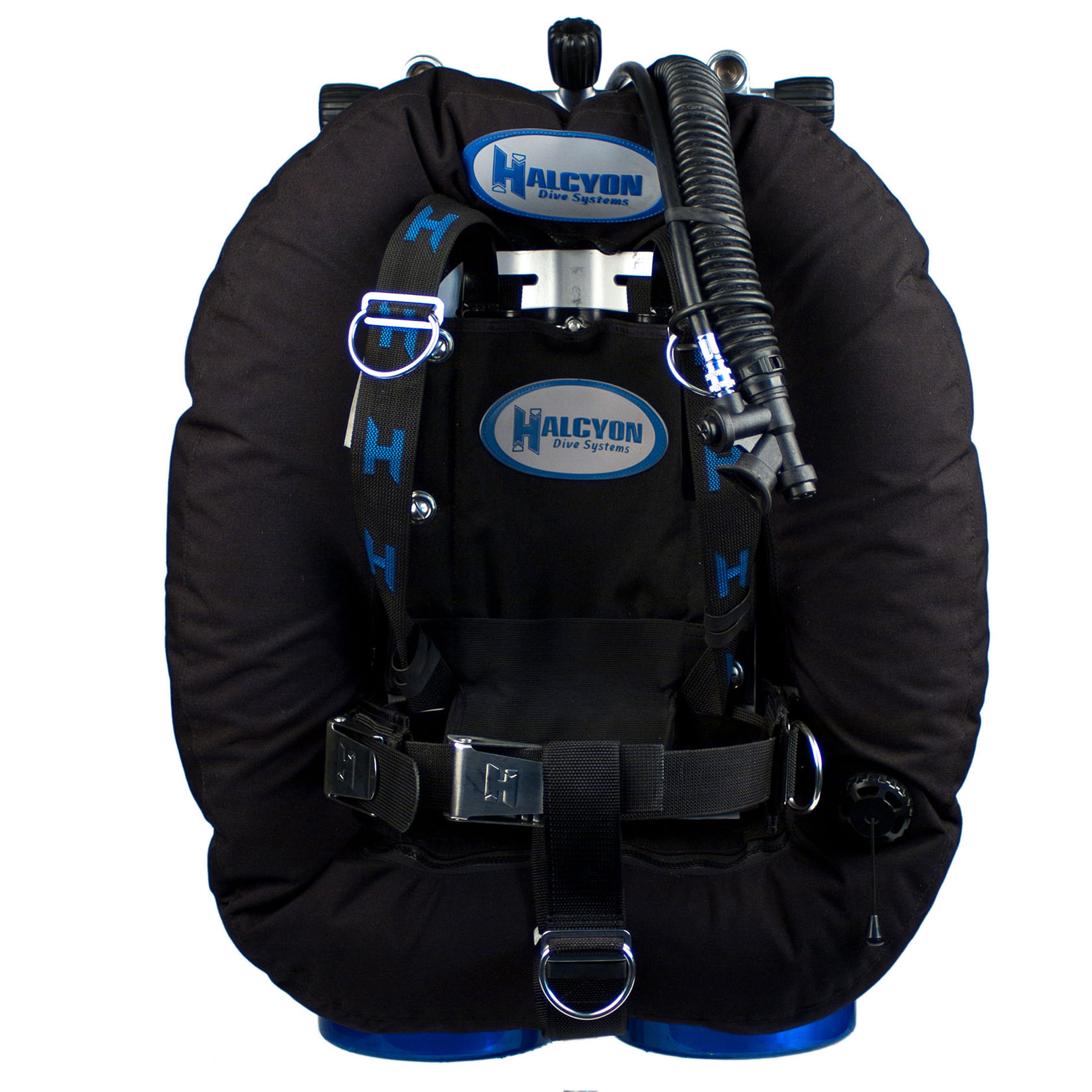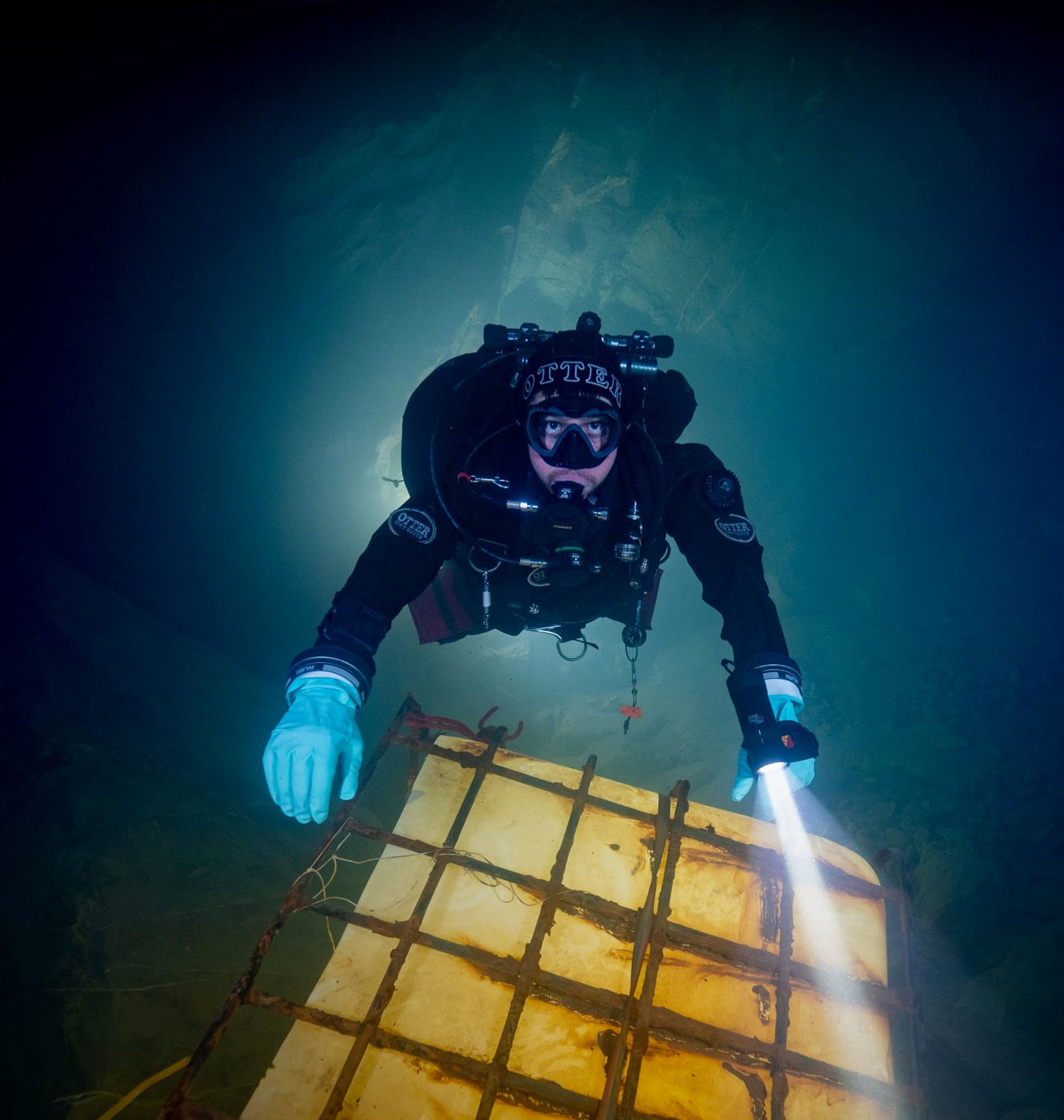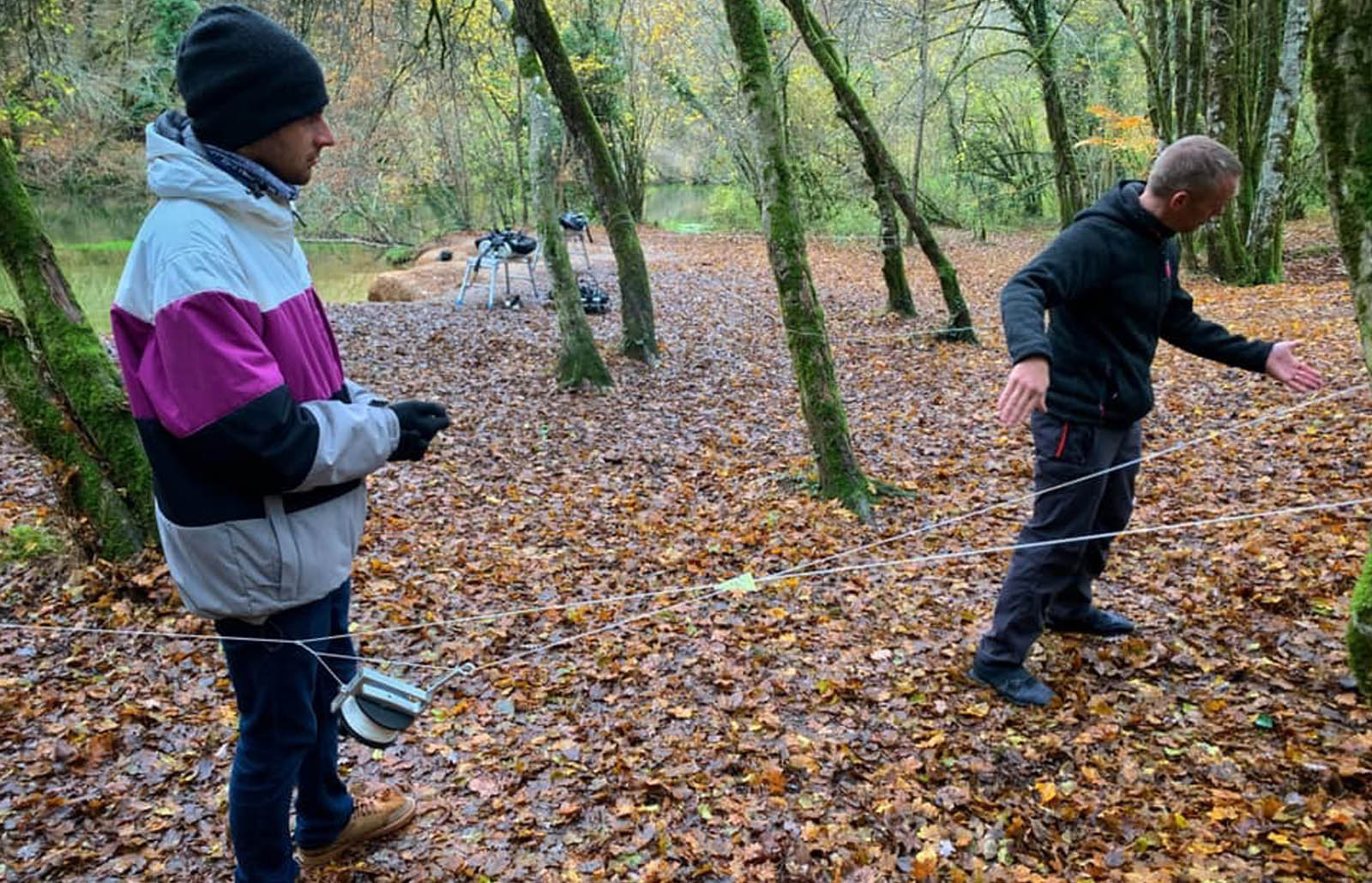
So you want to learn to cave dive…?
Learning to cave dive (and later becoming a cave diving instructor) has been among the most challenging and rewarding things I have done. You will never regret starting to cave dive, although your partner and bank balance may sometimes argue otherwise 😉
It is not my intention to go into every facet or detail of cave diving here, but I will try and provide you with a general overview. Based on my experience, both as a student and an instructor, the good the bad and the ugly.
You have probably seen a load of really cool pictures and videos on social media, and I even have some of mine on this post for you. And yes, of course, they look great. However, right from the start, you should know that it’s not all crystal clear and warm cenotes with stunning formations. Often the water is already low on visibility and easily silted out. It can also be frigid, making for quite a demanding environment.
Cave diving is quite a leap from recreational diving. As such, the length of the journey you take will always be dependant on your starting point. Different equipment and techniques are required, and your basic diving skills should already be second nature. You should, as a minimum, have some entry-level technical diver training/experience before you start.
As a cave diver, you will get the opportunity to explore these unique environments in the underground world. It is a fantastic experience! From the well-lit cavern areas through to narrow chambers, jagged walls with different colours and textures through to large decorated halls full of formations. There’s something new to see on almost every dive.
A cave diving course, like other technical diving courses, is challenging and focuses on the specific skills you will need to SURVIVE and then thrive as a cave diver. But be under no illusion, cave diving comes with intrinsically more risk – you rarely, if ever have direct access to the surface in an emergency!
If a problem occurs, it has to be solved in-water by the diver or dive team. Issues can range from reduced to zero visibility through to entanglements or equipment failures. To compound this, often such complications can vastly increase the time and gas volume required to return safely to the surface. As a result, increased redundancy and contingency planning is something you will become acutely aware off.
Perhaps you are now thinking this doesn’t sound like much fun, or maybe this is not for me. But wait for a second, as although it may seem scary at first, it is not! You will mitigate a majority of the risk and can dive in relative safety by; ensuring you are well trained, remain physically and mentally fit, stay within your limits and stick to the rules.
What should I know before commencing my cave diver training?
Previous Scuba Training & Student Pre Requisites
Redundant gas supplies are an absolute must for cave divers, as they offer an increased safety margin in case of failures. Typically by using double tanks, in either back mount or side mount configuration (or with rebreathers and bailout cylinders). For this reason, a direct transition from recreational (single tank) diving to cave diving, is not recommended.
Lack of preparation and diving experience is one of the biggest challenges I see with students, along with basic stuff like leaking hoses or SPG’s causing delays.
Use your Cave instructors time wisely – Be prepared for your course in advance, turn up with your core diver skills polished and be familiar in your equipment. Use the course time for learning cave diving, not going back over basics.
If you have no previous experience diving in a technical configuration, using redundant cylinders, you should as a minimum take an entry-level technical diving course. Having this knowledge will allow you to be comfortable in open water with the configuration before taking it into an overhead environment. Either the Intro to Tec Diver course utilising back mount doubles or the Technical Sidemount Diver course would be good options.
Additionally, you should have excellent buoyancy control and mastery of the various technical diving propulsion techniques. You will deploy all of these during your cave diver training. You will use flutter kick, modified flutter, frog kick, modified frog kick, back kicks and helicopter turns.
Buoyancy control and propulsion techniques are crucial in protecting the cave environment and ensuring you do not disturb any sediment. Each can ruin visibility and potentially escalate into a zero-visibility scenario, something you want to avoid!
Mental Attitude & Composure
In my opinion, one of the most essentials elements of cave diving is your mental attitude; this is something only you can control and understand. Inside the cave is not a place for unnecessary bravado (aka ego) or recklessness (aka stupidity). You need to be a reliable, responsible, a thinking diver and an active team member.
There is no place for panic during a cave dive (or any other technical dive). It will only add to further compounding an already stressful situation.
If you are;
- someone with a big ego
- that takes unnecessary risks
- who never has a dive plan
- regularly fails to conduct pre-dive drills or buddy checks
- just follows whoever is in front regardless
- sometimes finishes a dive on air reserves
- or perhaps dives well beyond their limits on ‘trust me dives.’
Then simply put, cave diving isn’t for you!
As a cave diver you will need to;
- be calm, collected, and able to work well under pressure
- have a healthy respect for the environment you are diving in
- be able to identify risks and ways to mitigate those risks
- be situationally aware and able to adapt/react
- be able to deal with potentially stressful situations if/when they arise (calmly & methodically)
Above all, you will know when it is the right time to call the dive. Remember that in cave diving, any diver can call any dive for any reason without having to explain themselves.
Cave Diving Equipment – General
It is essential before starting the course you speak with your instructor on their configuration preferences for the course. They may have reasons to opt for one configuration over another, such as choice of training location or the setup of other students on the course (and not wanting mixed teams). Whatever is decided upon by both you and your instructor, you should be both comfortable and competent in its use before the course starts.
In an ideal world, you will use familiar equipment, which you probably already own. But if you need to hire equipment for the course, I would highly recommend an extra day before your course starts. Use this for conducting check dives, gaining familiarity with the hire equipment and making any adjustments deemed necessary. The additional time taken here will help avoid delays and frustrations during the actual course itself.
Buoyancy Device & Cylinders – Backmount by far is still the most widely adopted configuration among both technical and cave divers. Although the use of side mount configurations is definitely on the rise even among open water divers, both of these configurations have pros and cons. So it is more about your personal preferences and the types of environment in which you will be diving. Whatever the setup, the essential take-home here is to be comfortable and familiar in your chosen configuration and equipment. And use the right tools for the job in hand.
If diving in back-mount we would recommend utilising a twin 12 configuration and if in side-mount a pair of Ali ’80s. These two options will place you in the most widely adopted equipment configurations. You are then giving yourself the best chance of matching your cylinder configuration with your dive team. You will learn more about this during your training.
What are the considerations for sidemount diving? Find out more here.
Drysuit & Thermal Comfort
I have already spoken about the need for redundancy. And this is true for buoyancy. Unless you are diving redundant bladder systems, you will need a drysuit. Not just for its thermal protection benefits, but to serve as your redundant buoyancy.
While on topic, I also feel the need to hammer home the importance of thermal comfort. Groundwater in the phreatic zone is often much colder than the water in the ocean (but not always the case). It is common to see students struggling with the cold. And often this is easily avoided if you have a properly fitting and well-maintained drysuit. Make sure you check it and where necessary have it serviced before the course.
Cave Diving Equipment – Specific
The cave specific equipment you will use during your course can typically be loaned/hired from your instructor and then purchased afterwards.
Reels and spools – Both used to maintain a continuous guideline to the surface. Commonly deployed in open water, a line is laid from the reel until it is possible to join onto the mainline. Spools are then used throughout the cave dive, typically as safety spools and jump spools. There are some limitations on this, during the entry-level courses. Such as not being allowed to make jumps from one line to another. You will learn more on jumps during your full cave diver course.

Line Markers – Used for navigation (aka decisions) they come in the form of arrows, cookies and rems. There are other non-standard markers deployed in specialist environments. One such example is the use of clothes pegs instead of cookies when a thick permanent line has been installed (typical in UK cave systems). Also, you will often see permanent system markers. These are akin to signpost on the roads, letting you know distances or location in the cave.
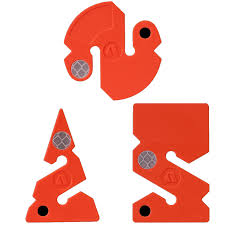
Cutting Devices – When cave diving, it is recommended to carry at least two cutting devices. And you should be able to reach at least one of them with each hand. We recommend having three cutting devices. The primary one attached to the dive computer on the right wrist (Ezycutter). The secondary on the left side of the waist belt (DIRzone knife). And a third in reserve, situated where ever suits you best (mine is a small knife located under my torch goodman handle, held in my left hand).
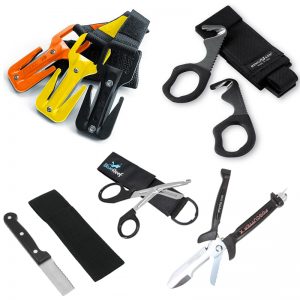
Lighting – You will need to carry a minimum of three lights on every dive. One primary light, with a sufficient burn time and a focussed beam. Another two backup lights with a combined burn time equal to that of your primary. Lighting is crucial to cave diving for obvious reasons. As such, this is one place where we recommend doing your research and not skimping on the amount you will budget to spend.
You can opt for external battery (with chord) or internal battery (without chord). Your primary will always need to be mountable, generally on a goodman handle. Your lights can also be helmet mounted, but with caution. When doing so, light discipline and communication options become restricted with this option.
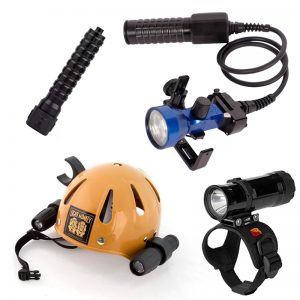
What are the different types of lighting options, and what are the main things to consider? Find out more here.
The Training Journey
Learning to cave dive is not something you want to rush. You really should invest in your training (and yourself). It may just save your life!
Ensure you receive the best training possible and then take the time to gain sufficient experience before proceeding further on your cave diver training journey. Starting with this mindset, you will embrace your learning as a process, rather than a race to the end.
Recommended Training Route – Each level of cave diving becomes the prerequisite of the next, meaning the courses run in sequential order. Starting with Cavern Diver, then Intro to Cave Diver, then Full Cave Diver and after those the various Cave Diver Specialities.
However, it is possible to combine specific courses. Which in-fact is often a more logical route due to crossover of skills. And it can also help with reducing the cost and scheduling commitments from work/family life.
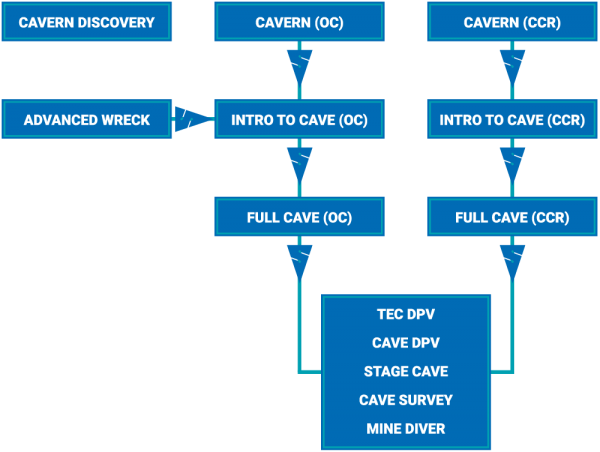
Take a look at all of our cave diving courses here and our see our price list here.
Cavern Diver & Intro to Cave Diver (Combined) – We highly recommend starting by combining the Cavern Diver and Intro to Cave Diver courses. These can typically be jointly delivered in 4-5 days depending on various factors. You then finish the course combination as an introductory level cave diver and may go and dive in the caves without an instructor present.
Slow Down & Build Experience – Before proceeding further in your formal cave diver training, go and dive your newly acquired skill set. Build on your intro to cave course by cave diving with experienced cave diver friends (but always choose your cave diving buddies wisely). When you have built up sufficient experience at the introductory level, you should then consider the Full Cave Diver course. An excellent point to be aiming for is approximately 30-40 intro-level cave dives before you proceed with further training. But ultimately, when you feel ready to progress, speak to your instructor.
In-water experience is a crucial element of your learning journey. I urge you to slow down between courses, take the time to make a sufficient (or recommended) amount of dives before you seek to progress onto the next level.
A general rule here is 20/80. Your training should take up 20% of the dive count, and the remaining 80% should be personal dive count gaining experience. So if a course takes 8 dives to complete (20%), you should look to make another 32 dives (80%) as a minimum before looking to progress.
A helpful article written by one of my former instructors found here is entitled ‘Slow Down Young Fella.’
Full Cave & Stage Cave Combined – It makes sense to combine the Full Cave Diver course with the Stage Cave Speciality. Again there is a significant amount of crossover here. Bringing these two courses together allows you to carry out complex navigation and move into the advanced gas planning for multi-stage dives. At this point, you are at the pinnacle of your cave diver training. A big pat on the back for you!
Cave Diver Specialties – Now the choice is yours. Perhaps its Cave DPV or maybe you are interested in moving over to CCR Cave. Whatever your choice, as always do your homework. And as always be prepared to invest in yourself, your equipment and your training.
What Now…?
Hopefully, having reached this point, you are now a little clearer about the journey and process of learning to cave dive. And perhaps you’re ready to get booked onto your first course.
Whatever stage of the cave diver training journey you are at, we would be happy to engage with you and assist you wherever possible. For more information, check out our courses and price list or feel free to get in touch with us using the form below.
About the author : Matt Brooker
Recreational, Technical & Cave Diving Instructor @LearnToCaveDive.com and @UberScuba.eu Primarily focussed on teaching the TDI range of courses.
Join our mailing list today
Upcoming course dates, special offers and insider information.
Stay up to date with our latest news, course schedules, group trips and special offers.


